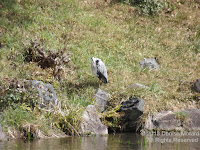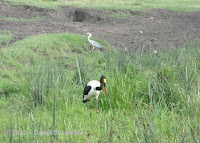GREY HERON
GREY HERON (Ardea cinerea) – (See images below)
DESCRIPTION: The Grey Heron has a white head and neck and a grey body. In adults there is a black stripe above the eye. The wing feathers are edged in black. The yellow bill is long and pointed. The long slender legs are pinkish grey. The eyes are yellow. Sexes are similar. These birds stand at around 3 feet (one meter) tall.
VOICE: https://www.xeno-canto.org/species/Ardea-cinerea
NAME: The name ‘Heron’ has a complicated origin and evolved from an ancient Greek word meaning ‘to creak or screech’ (in reference to that bird’s call). The Latin genus name ‘Ardea’ means ‘heron’, and the Latin species name ‘cinerea’ means ‘ash-colored’.
HABITAT: Grey herons wade in shallow waters, whether in rural or urban environments.
DIET: Mainly fish, speared with the bill.
NESTING: Grey herons nest as a colony called a ‘heronry’, which consists of a group of several nests atop mature trees, as can be seen below. The nest is a large structure of sticks and lined with finer materials. Between three and five blue-green eggs are laid, incubated by both parents. They are also both feeding the young.
DISTRIBUTION: The grey heron is an Old World species. It breeds in middle Europe and Asia. It is a year-round resident in Western Europe, southeast Asia and Africa. Its wintering grounds cover the coasts of the Mediterranean, middle Africa and the Vietnam-Cambodia peninsula. Some individuals have been able to reach Hawaii as ‘vagrants’. (See note below for information on bird vagrancy.)
CONSERVATION: The grey heron is widespread and its population generally stable and considered at risk.
NOTES: Young herons, until they can fly, are very vulnerable to disturbances and, if they fall off the nest during that period, the parents will no longer feed them and they will starve to death, or they may get killed during their fall or eaten by predators on the ground.
Vagrancy: In biology this means an animal going way outside its normal range. For birds, this can happen when there are storms and they get blown off course. On other times, the bird simply wanders in a different direction than usual. Here’s an article about vagrancy in birds.
SIMILAR SPECIES: Great Blue Heron, to which the grey heron is closely related.
REFERENCES: https://en.wikipedia.org/wiki/Grey_heron
http://www.oiseaux-birds.com/card-grey-heron.html
https://www.beautyofbirds.com/greyherons.html
https://www.rspb.org.uk/birds-and-wildlife/wildlife-guides/bird-a-z/grey-heron/
DESCRIPTION: The Grey Heron has a white head and neck and a grey body. In adults there is a black stripe above the eye. The wing feathers are edged in black. The yellow bill is long and pointed. The long slender legs are pinkish grey. The eyes are yellow. Sexes are similar. These birds stand at around 3 feet (one meter) tall.
VOICE: https://www.xeno-canto.org/species/Ardea-cinerea
NAME: The name ‘Heron’ has a complicated origin and evolved from an ancient Greek word meaning ‘to creak or screech’ (in reference to that bird’s call). The Latin genus name ‘Ardea’ means ‘heron’, and the Latin species name ‘cinerea’ means ‘ash-colored’.
HABITAT: Grey herons wade in shallow waters, whether in rural or urban environments.
DIET: Mainly fish, speared with the bill.
NESTING: Grey herons nest as a colony called a ‘heronry’, which consists of a group of several nests atop mature trees, as can be seen below. The nest is a large structure of sticks and lined with finer materials. Between three and five blue-green eggs are laid, incubated by both parents. They are also both feeding the young.
DISTRIBUTION: The grey heron is an Old World species. It breeds in middle Europe and Asia. It is a year-round resident in Western Europe, southeast Asia and Africa. Its wintering grounds cover the coasts of the Mediterranean, middle Africa and the Vietnam-Cambodia peninsula. Some individuals have been able to reach Hawaii as ‘vagrants’. (See note below for information on bird vagrancy.)
CONSERVATION: The grey heron is widespread and its population generally stable and considered at risk.
NOTES: Young herons, until they can fly, are very vulnerable to disturbances and, if they fall off the nest during that period, the parents will no longer feed them and they will starve to death, or they may get killed during their fall or eaten by predators on the ground.
Vagrancy: In biology this means an animal going way outside its normal range. For birds, this can happen when there are storms and they get blown off course. On other times, the bird simply wanders in a different direction than usual. Here’s an article about vagrancy in birds.
SIMILAR SPECIES: Great Blue Heron, to which the grey heron is closely related.
REFERENCES: https://en.wikipedia.org/wiki/Grey_heron
http://www.oiseaux-birds.com/card-grey-heron.html
https://www.beautyofbirds.com/greyherons.html
https://www.rspb.org.uk/birds-and-wildlife/wildlife-guides/bird-a-z/grey-heron/
 |
| Grey heron, Kamo River, Kyoto, Japan |
 |
| Grey heron, Kamo River, Kyoto, Japan |
 |
| Grey heron in a pond, Kyoto, Japan |
 |
| Grey heron in resting position, Kyoto, Japan |
 |
| Grey heron on one leg, Kyoto, Japan |
 |
| Kyoto pond, hangout for grey herons |
 |
| Grey heron heronry, Tokushima, Japan |
 |
| Grey heron, Saddle-billed stork, Tanzania |
 |
| Grey herons at top of trees in heronry Tokushima Central Park, Japan |